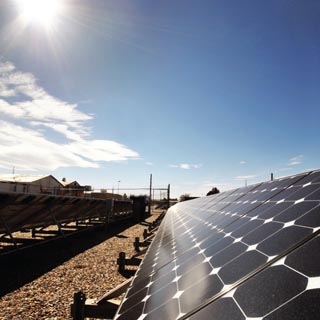
Sandia has a long history of measuring and modeling performance of PV systems, from single panels to multimegawatt arrays, the kinds of systems found on residential rooftops and small businesses.
Sandia is advancing viable, low-carbon power through its collaboration on five US Regional Test Centers (RTCs) where industry can assess the performance, reliability, and bankability of large-scale photovoltaic energy systems.
“With the trend in the solar industry toward larger systems and greater capital investment — substantial amounts of money are going into this field — the financial community is increasingly scrutinizing how well these systems operate,” says Charles Hanley, manager of Photovoltaic and Distributed Systems Integration Dept. 6120. “The RTCs will provide enhanced monitoring and improved performance prediction capabilities for new technologies being introduced to the market.”
Photovoltaic (PV) modules convert solar radiation into electrical current using solar cells containing semiconductor material. Demand for renewable energy has produced an industry around the manufacture and installation of solar cells, photovoltaic arrays, and other components such as inverters, trackers, and racking systems. Demand has also produced a need to build investor confidence in larger PV systems by assessing performance over time in different climates.
Sandia has a long history of measuring and modeling performance of PV systems, from single panels to multi-megawatt arrays, the kinds of systems found on residential rooftops and small businesses. “Sandia works in partnership with the US solar industry to advance the state of the art in system integration and system optimization,” Charles says.
Sandia researchers a few years ago developed the idea of an incubator for commercial-scale PV systems up to 500 kilowatts or a megawatt, the size found on big-box stores or schools. The Labs’ National Solar Thermal Test Facility (NSTTF) was quickly identified as a perfect site for such a PV testbed.
At the same time, DOE was working with industry and stakeholders to determine their most pressing needs. The agency hosted a workshop in Berkeley, Calif., on PV manufacturing attended by the CEOs of module manufacturers and members of the financial community.
“It was clear from the workshop that the broad community wants better ways to quantify technical aspects to support the bankability of PV systems,” says Jennifer Granata (6112) of the Labs’ solar group.
Bankability is a measure of a project’s risk to an investor. The lower the risk the more bankable it is, thereby lowering associated financing costs. The technical risk must be quantified to make PV systems more commercially viable.
“The RTCs will develop protocols and conduct testing and analysis on the systems that can give investors some concrete data with which to assess the risk,” Jennifer says.
A good fit for Sandia
She says the PV world until now did not have full and independent standardized processes for monitoring and evaluating large systems. The country’s few other PV test sites accommodate only small systems.
The workshop attendees asked DOE to develop test locations for large arrays where PV manufacturers could try out new designs and systems and get reliable data. “It fit with the Sandia idea on system incubators,” Jennifer says. “We had ideas on how this could work.”
DOE asked Sandia and the National Renewable Energy Laboratory (NREL) in Golden, Colo., to submit proposals for what the agency named Regional Test Centers. Jennifer led a team effort to develop a Sandia proposal for testing infrastructure and a validation plan to measure and evaluate performance and reliability.
DOE decided to fund physical and data monitoring infrastructures and validation plans at five locations in different climates, with Sandia and NREL working together on the overall project management. Sandia manages four of the five locations with local partners: Albuquerque; Orlando, Fla., Burlington, Vt.; and Las Vegas, Nev. The fifth location, Denver, is managed by NREL.
The sites are in varying stages of development, from early planning to ready-to-go. Each will put in infrastructure up to one megawatt, so multiple different-sized systems can be tested. At Sandia, the project has started on eight acres at the NSTTF with an option to expand by an additional 30 acres. Infrastructure includes a road, communications equipment, and the electrical lines for monitoring systems, transformers, and switches.
“Most of the work is underground,” Jennifer says. “Companies can come in and put a PV system in place. AC goes right to the grid.”
Jennifer says key components of the RTCs are the processes, standards, and guidelines for validating large PV systems. Experts from the participating sites have developed a validation plan with step-by-step processes to assess and quantify system performance.
“The Regional Test Centers, with lab expertise, can provide an independent, third-party perspective, and test beyond the standard protocols to improve our understanding,” Jennifer says.
RTCs are a part of DOE’s SunShot Initiative, a collaborative national effort to make solar energy cost-competitive with other forms of energy by the end of the decade. DOE wants to encourage widespread, large-scale adoption of renewable solar energy technology and restore US leadership in the global clean-energy race.
Charles says the RTCs are an important part of the effort. “This will produce improvements in performance monitoring that can greatly reduce the uncertainty around investing in large-scale projects and therefore help keep the dramatic growth in this market on track,” he says.